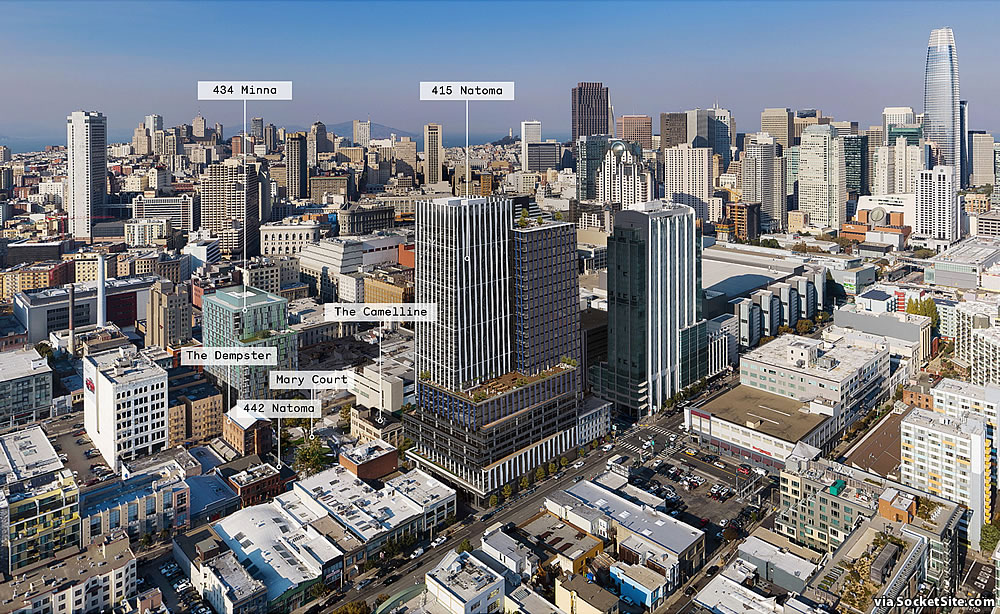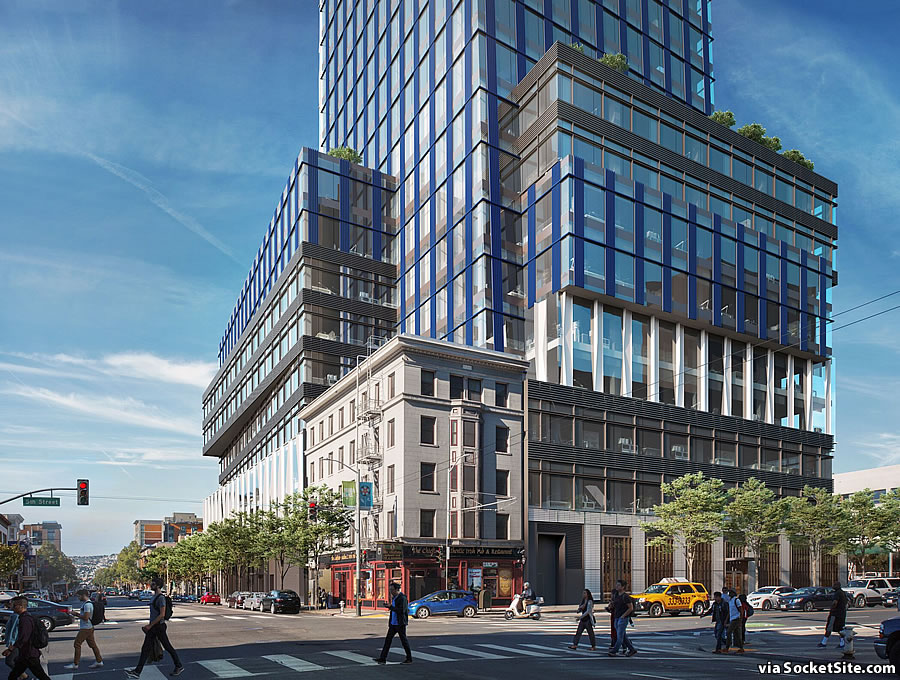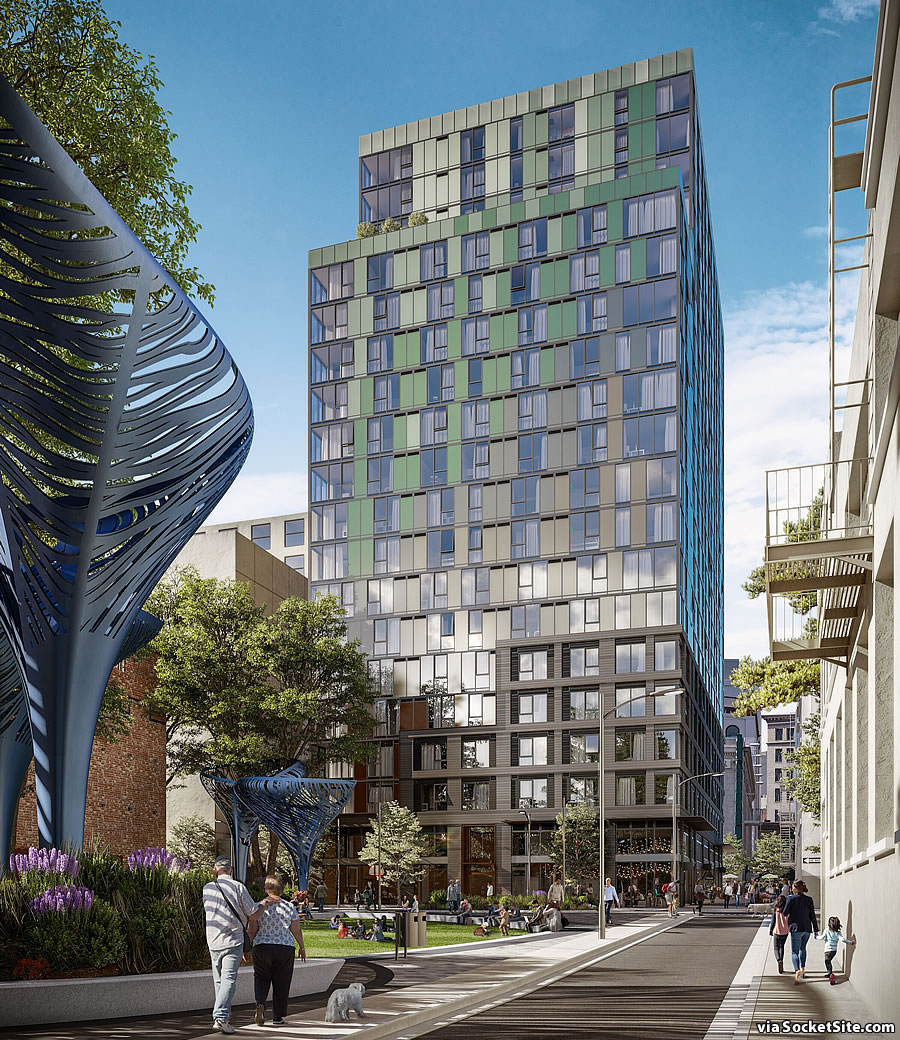The 25-story tower rising at 415 Natoma Street, the first building of the massive 5M Project, which spans a 4-acre South of Market site stretching from Mission to Howard and Fifth to Mary, has officially “topped out.”
And with around 14 million square feet of vacant office space currently spread across San Francisco, the 640,000-square-foot office tower which wraps around The Chieftain at the corner of Fifth and Howard and was designed by Kohn Pederson Fox (KPF) and House & Robertson Architects to attract “modern HQs,” but has yet to ink a tenant, is on track to be ready for occupancy by the end of the year.
Construction on the 302-unit, Ankrom Moisan designed apartment building rising at 434 Minna Street, along Mary to Mission, is on track to be completed by the end of the year as well, along with with the renovation and repurposing of the historic Dempster building (with dedicated space for arts, cultural and educational uses) and a new Mary Court park between.
And while not rendered above nor under construction, plans for a modern 400-unit condo tower to rise up to 470 feet in height along Fifth, between the new 415 Natoma tower and Hearst’s historic Chronicle building at Fifth and Mission, which is to be renovated, with the addition of a 23,000-square-foot rooftop park, remain in place but have yet to be scheduled.



Very bad timing. Unlike Oceanwide where the developers cut their loses and abandoned the project with just the foundation completed, this tower was already mostly built when Covid hit.
Targeted to HQs [when] HQ’s are leaving SF, not coming to SF. The Salesforce permanent work from home situation could be devastating on the SF office market. Potentially adding hundreds of thousands of feet of space to the sublease pool. Not to mention Uber’s putting several hundred thousand feet of it’s planned HQ up for sublease. Not far from this site Yelp just put 10 floors of its New Montgomery headquarters on the market as it shifts to permanent work from home and potentially moves its SF headquarters out of the City..
We are experiencing a revolution in how and where people work. It will not reverse. Many are in denial – reminiscent of the emergence of the auto at the time of the horse and buggy. San Francisco is especially susceptible to an emptying out of much of its office workforce in part because of the difficulty of getting into the city as well as the condition of the streets. The financial impact will be huge as the payroll tax collapses as do the taxes from all those businesses in the downtown core that catered to the large workforce Many of these businesses will not reopen.
Probably correct – the wave of unintended consequences from the work from home and the new reality post pandemic may leave SF with a huge surplus of space, added to that the overbearing California Anti-Business work laws and SF corruption and incompetence. grab the popcorn, it’s gonna get ugly.
Agree in some, disagree in others.
Agree that it’s a terrible time to be developing offices, that there is a work revolution underway, that SF is susceptible, and that downtown service businesses are in trouble.
I think memories will be short when it comes to COVID, though. Yes, five days a week in the office is overkill, but I think most companies will land on 3/2 or 2/3 as an office/home split. Critical meetings are still best in person, young people want to be in an office collaborating and doing happy hour after. I see many companies downsizing but not eliminating completely and moving to a desk-sharing model. This means price reductions on office space, which in turn incentivize companies to keep/open an office since prices are reasonable.
It won’t be a total shift but significant enough to empty out downtown compared to the boom times. Yes there will be need for face to face meetings and offices but think out of the box. If your workforce is scattered in various locales the need for get together office space will be met by setting up hub offices – convenient to the bulk of your workers. The meetings do not need to take place in SF and especially given transportation logistics.
Keep in mind that many workers are embracing telework as an opportunity to buy a home. For those with existing homes the draw will be the ability to get larger properties. In Sacramento several new developments feature “huge” homes. 2800 square feet and more – specifically catering to that now mobile Bay Area workforce. If your workforce is scattered from Napa and Sonoma to Solano and Sacramento and southern Santal Clara counties where would you put your office sharing offices? Especially if your workforce is 3/2 days in the office. Not downtown San Francisco but the Tri-Valley area and Concord to name a few more practical spots for hub offices.
Agreed about expansion to the exurbs and that places like downtown Oakland, Walnut Creek, Pleasanton, Santa Rosa could soak up more office space. We could end up seeing lots of 2K-10K square feet regional hub offices. One in SF, one in Walnut Creek, one in Santa Rosa, one in Santa Clara…or maybe WeWork makes a comeback off of all of this…
The impact of COVID, specifically WFH, may be small on actual leasing – assuming the office isn’t abandoned altogether (it actually might help, if reducing density is seen as a goal), but what will be clobbered is all the retail and public transit that supports it. A person who needs an office will still need the same X gsf, whether they’re in it 40hr/week or 4, but they’ll only buy lunch a fraction of what they used to. And public transit: either the drivers/operators will be let go – yeah right….like THAT’s gonna happen !! – or the deficits will become even more astronomical than they already were.
Yes, I’m very fearful for the Mom and Pop businesses who set up downtown and relied on the lunch crowd. Agree on public transport as well. Uber/Lyft were already a growing competitor, then scooters/ebikes, and now a likely commuter traffic haircut of…30%?
A haircut – a little off the top – might be OK, actually a good thing if it reduces crowding and kills off some of these hairbrained…er, harebrained expansion ideas (granted a big “if”). If it’s a 50-70% and up loss – a mohawk – that’ll be a death blow.
Not all WFH situations are the same. Some are partial situations and others complete – as with Twitter. Salesforce will be telling as supposedly 80% of it’s workforce will be eligible. If it is a partial WFH situation at that level it is hard to see Salesforce not dumping a large chunk of its downtown office space. If 1000 workers are in a building each day it will drop to 400 or so with 3 days telework/2 day in office work. One could reduce worker density/increase individual workspace a lot and sill have lots of unused office space , space companies are not going to continue leasing.
Agree about public transportation. This certainly obviates the need for a second BART tube to SF It also makes doubtful the prospects of a second tube from Oakland to the SSF/SF Airport area. HSR and the CalTrans extension to downtown SF are not needed and neither will see the light of day.
Wouldn’t HSR be more valuable in a world where 20% of the Bay Area flees to LA/SD (see name link for evidence of a trend) for sunnier skies?
@Freeloader – there is migration from the BA to SD but the much large migration is to other states or even the Central Valley. California is losing population now and prior to the pandemic the population growth was anemic and mainly fueled by non-native immigrants. HSR is pointless in a future where workers will be spread across larger geographic areas and a concentrated core of jobs as SF had will become less and less the norm.
Actually you will likely see more companies go towards the hoteling model – whereas you don’t have a dedicated desk/office but would have to reserve it and/or have allocations for each department which are shared.
The big consulting companies have been using this model forever and any company that is still going to keep a physical office space should be actively pursuing this model to reduce their overall footprint.
We will see how this WFH plays out after people get their shots. A lot of people think WFH sucks, so just because you can WFH doesn’t mean everyone will.
I think that’s why people have been putting so much weight on the Salesforce, Yelp and Uber decisions made post-vaccine. There was speculation that once a vaccine was out people and companies would be rushing to ‘front run’ back. But so far rents have continued to decline and companies have continued with their plans to slim down their SF presence.
I think it was the poster “Brahama” who pointed out that most of the people who think WFH sucks seem to be from the real estate industry.
“who pointed out that most of the people who think WFH sucks seem to be from the real estate industry”
What was the criteria for that data subset ?
True. Beyond that there is the smaller subset of companies going total telework (5 days a week). Those workers are free to live hundreds of miles and more from their company’s headquarters. Jackson County in the Rogue River area has seen the median home price spike from 260K or so to almost 400K in the past year. It is not driven by California retirees relocating there but rather an influx of permanent teleworkers from the Bay Area and Socal. A friend has moved there and the only stipulation from his company is a quarterly trip to HQ. This friend is hoping that a hub office is set up in Medford or Roseburg to offer a closer place for that quarterly trip and if so, what the hay, make it a monthly trip.
The wildcard is how permanent telework plays out with its potential to further diminish/disrupt the need for a large footprint in a metro like SF. .
Apparently another unforeseen kick on effect from partial WFH is the following. The 3 day option is most coveted, and everyone wants T-W-Th, understandably, for the nice long weekend ability. But what that causes is then a soft Thursday afternoon across teams as members game weekends and traffic, and conversely a crushing T-W workload. Then, for other teams who are not part of the T-W-Th in-office groupings, insert problems when collaborations with other groups outside their times, and into the most coveted slots … things can languish for several days plus the weekend plus a Monday before they get finished.
Tu-Th is coveted but not great for the reasons you outline. I think MWF sucks for Tahoe trips but gives a day between to have fewer meetings and think through things before more meetings.
TuTh gives that break as well. It means cramming in even more meetings in those two days. I don’t know if Thursday would be soft when it’s only twice a week. More likely big happy hours or late nights out even for those with families.
Companies are not generally proposing to reduce the work week from 5 to 3 days. They’re just proposing to allow employees to work from home on some of those 5 days. There’s no long weekend when you’re attending conference calls from home at 8am Monday and 3pm Friday.
Indeed. But your words and human behavior are two different things.
5M is Hearst, basically. Anything Hearst touches is doomed. They’re ATT and SF is HBO. But then if you look around — there so much blingy, gross Hudson Yards wannabe black granite and brass, bitcoin & brew pub and bottle service, face-tatoo & implant sporting being slapped up in SF these days its hard to keep track. The city’s been carjacked by people with zero taste
As more office space opens up in SF, and office rent declines, companies that couldn’t afford or find SF office space will move in to vacant space. And people who want to live in SF will still live in SF– not everyone wants to live in Wyoming, even if they can work remotely. There will be a new equilibrium, which will become clearer in the months and years to come, after the pandemic is controlled.
A lot of younger workers aren’t crazy about WFH.
Why was my post removed?
It was both on topic and hilarious.
I’m a bear now, get used to it
This was a controversial and hotly contested project when approved by the Planning Commissioners and Board of Supervisors in 2015, in part due to the upzoning (160′ to 470′) that was involved. A deal was finally made in which the developer promised to build a considerable number of below market housing units (40%) both onsite and offsite. Would be interesting to know whether that housing has been or will be built or if the numbers will be adjusted.
I think the housing was in the “green” tower, and I don’t believe it’s broken ground….although in general seems city is erecting a lot of BMR’s at the moment.
As we outlined above, the so-called “green” building at 434 Minna Street has not only broken ground but is slated to be ready for occupancy by the end of the year (with 91 of the building’s 302 units to be rented at Below Market Rates).